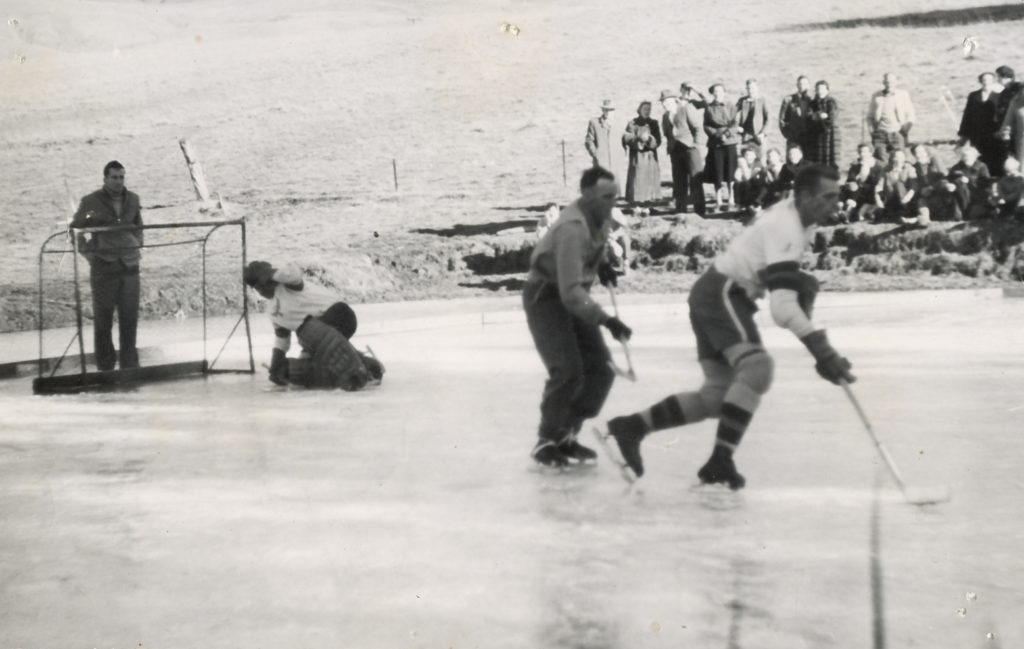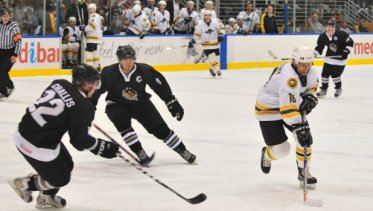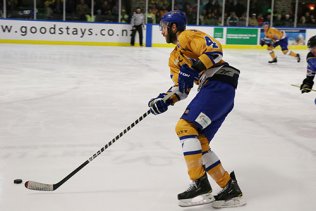
THE GLASS FAMILY: FOUR GENERATIONS OF…
The Glass family is no stranger to the Southern ice hockey community, with Simon Glass having captained the Sky City Stampede and Graeme Glass currently being part of the Executive Committee of the Queenstown Ice Hockey Association. However, their family’s accomplishments run much deeper than that. The Glass Family’s involvement in ice hockey dates back to over 70 years ago, and show no signs of slowing down with now a fourth-generation entering the hockey world. In part one of this two-part series, Graeme Glass shares his and his father’s journey with the game, showcasing just how the Glass family name is interwoven into the very fabric of New Zealand ice hockey history.
The Glass Family story starts with Ben Glass, who was born in 1926. Ben grew up on his family’s farm in Albury, a small town in the heart of rural Canterbury which is located between Fairlie and Timaru. There wasn’t a large selection of sporting activities available at the time, with their only options being what was available in the local district. There was very little ice hockey being played during the ’30s, where the rink would be a pond that had frozen over. Although numbers were small, there were enough to establish ice hockey club’s in Tekapo, Fairlie, Mt Harper, and Irishman Creek. A man by the name of Matthew Wills owned a farm called Opawa. Though he was mute and deaf, Matthew had an interest in motorsports and ice hockey. This interest granted the ability for an ice hockey tournament to be held in 1937 at the large pond found at the front of the Opawa homestead. Wyndham Barker, the owner of the Mt Harper rink, donated the Erewhon Cup at this tournament. The Erewhon Cup is still used to this day for the Tekapo Erewhon Cup tournament, which is New Zealand’s oldest ice hockey competition. On the same day as the tournament, a meeting was held which resulted in the formation of the New Zealand Ice Skating Association. A few years later, a purpose-built ice skating rink was built at Opawa, which Graeme describes as “a popular spot for ice skaters from Timaru in the 1950s and 1960s”.
Ben Glass first became involved in ice hockey by playing for the Opawa Club. He became a member of the Opawa team and went on to win the Erewhon Cup twice: the first in 1946 and for a second time as captain in 1951. His brother, Ted, also played as a goalie for the Opawa team alongside Ben. The level of the equipment in those days is incomparable to what players wear today. Graeme explains just how different the game was between when his father played vs current day hockey. “The players on the teams were mostly farmers and farmworkers who played in their everyday clothes with a pair of leather gloves if they were lucky. In most cases, the goalies knelt on the ice often as they couldn’t skate very well! At the time, there was a team from Christchurch called International and they were fully padded up like today, but they were the exception.”
Ben had various roles in ice hockey, the most notable being his role as hockey convenor for the Opawa Hockey club, as well as being the Opawa Club representative on the Hockey Committee of New Zealand. Ben hung up his skates in the early Sixties, which was gutting for Graeme as he loved to watch his father play. Graeme describes his father as, “Having the reputation of being a very good and uncompromising hockey player.” Though Ben had retired from playing, he didn’t stray far from the ice, becoming more involved as a referee in a number of important games, including several Erewhon Cup finals way into the early ‘70s.
Graeme and his sister Elizabeth grew up around an ice rink as their father, Ben, bought the Opawa farm. Graeme says that “Skating was something we did every minute we could during the winters, which were a lot colder back then.” As Ben Glass was heavily involved in the Erewhon Cup, it’s no surprise that Graeme’s earliest memory of ice hockey comes from there. “The Erewhon Cup final in 1959 was between Opawa and Christchurch’s International. I was very impressed with a player from International called John van der Griend, and I remember him and Dad battling it out on the ice. Over the next few years, I tried to emulate the van der Griend style of side-to-side stickhandling.”

Ice skating became a popular activity in the district according to Graeme. He describes that, “The local children would get off the school bus at our gate and go skating. The boys would get out some hockey sticks and knock around blocks of wood- pucks were pretty scarce back then.” In 1960, an ice rink had been built at Albury, meaning that the children were now able to skate at school. Graeme’s first games of ice hockey were inter-school games between the Albury and Opawa schoolboys, where he played for Albury. In 1965, Graeme played in a combined team that had recently formed, and they went head to head with the boys from Mt Hutt in middle-Canterbury. Ben Glass was involved in setting up these games, along with parents from Albury.
Graeme headed to a boarding school in Timaru which limited the amount of skating and ice hockey he was playing. His skating days were restricted to the odd Sunday he would have off, where his Aunt would take him home to skate for the day. Graeme goes on to say, “I would spend hours on the ice, playing games against imaginary opponents and working on my skating, stickhandling and shooting techniques.” Graeme’s first game of senior-level ice hockey was in 1968, where he represented the Opawa team in a preliminary round for the Erewhon Cup. Graeme remembers, “I scored the opening goal early in the game, but then the Albury boys shut me down. They were a good team and went on to win the Erewhon Cup that year.”
In 1970, Graeme went back home to work on the farm and at this time, the Opawa Club was struggling to put together a team. Graeme was asked to play for Albury, where the team came out victorious and won the tournament. However, the Albury team shared the trophy with the Christchurch Centaurs due to a draw being declared in the final game. Graeme recounts that it was “A pretty torrid final. We were all tied up at full-time and still tied up after two overtimes, and so we decided to share the trophy.” The Albury team won the Erewhon Cup in 1971 and 1972, however, in 1973 there was a period of warm winters which meant that the ice was not in a skatable state. Despite this, a few games were played during this year but only quickly-arranged games, Graeme concludes “We didn’t really play any hockey until 1986 aside from a few games in Tekapo.”
Graeme first became involved in the administration side of ice hockey in 1970, where like his father he became the hockey representative of Opawa at the New Zealand Ice Skating Association. Fast forward to what is New Zealand Ice Hockey’s most important year: 1986. In the spring of ‘86, a meeting was held in Tekapo where the outcome was the founding of the New Zealand Ice Hockey Federation. Graeme tells that “I first knew of the meeting when I got a call from Peter Anderson telling me that he had been at this meeting and a New Zealand team was going to be selected on a regional representation basis and that this team would be playing next year in Australia.” Peter Anderson, a prominent figure in the history of New Zealand Ice Hockey, and Graeme ended up being the Albury Club representatives for the team. Graeme explains that “Each of the Southern Clubs got to put two players forward for the team and the remainder of the spaces were to be filled with players from Canterbury.”
Aside from a few training camps in Christchurch, the team was thrown in the deep end for a reality check when they went to the IIHF World D Pool Championships in Perth, Australia. “I had pretty high expectations, but these were very quickly dashed when we were thrashed by South Korea.” Not only was the team thrashed by the South Koreans, but they were subjected to absolute annihilation by Australia with a whopping 58-0 loss, making it New Zealand’s biggest defeat in ice hockey to this date. Despite this, the New Zealand team won their games against Hong Kong and Chinese Taipei, securing themselves a bronze medal at the tournament. Graeme mentions, “I remember being incredibly excited and proud to step on the ice with a New Zealand shirt on. Our coach Brian Lewthwaite told us that the Koreans would be small and that we should go and knock them around. I stepped onto the ice and the first Korean that I lined up had seen me coming and stopped quickly, watching me slam into the boards and then he laughed. Years later, my son Simon was playing for the Ice Blacks in Croatia and I was there; they were versing Korea and he absolutely smashed this Korean player then skated over to the bench and said ‘that was for you, Dad.’ ”

Graeme and Peter Anderson played together for the Kuhtze Flyers team in the Canterbury league and went on to play for the Flyers in the inaugural NZIHF Club Championships in 1987. That same year was the 50th Anniversary of the Erewhon Cup, and so the Albury team was resurrected. The Albury team, which Graeme was part of, went down to Queenstown for the tournament and won the cup. Graeme then played for the Southern team against Auckland at the nationals which were held in Christchurch. Graeme continued to be part of the administration of New Zealand Ice Hockey, where he attended an NZIHF annual general meeting and was nominated to be Vice-President from the floor. During that time, Graeme was also named as a member of the training squad for the New Zealand national ice hockey team and was to travel to Belgium in 1989.
Graeme was later named manager of the team that was heading to Belgium, so he had to choose between playing or acting as manager. He opted out of playing, yet still had the experience of a lifetime. Graeme shares that “This was a pretty big step for me as I had never been to Europe before, but it all came together and the New Zealand team played in the D Pool of the IIHF World Championships and versed Belgium, Great Britain, Spain and Romania. Once again, we were outclassed in every facet of the game.” Rather than sitting on the losses, Graeme went to work and wrote a report for the NZIHF that outlined what needed to be done to develop the game and skills of players in New Zealand. What Graeme found necessary was to concentrate on teaching basic skills to new players so that in 10 years’ time New Zealand might become more competitive.
For the next few years, Graeme acted as both Vice President of the NZIHF and manager of the Ice Blacks on the 1994 tour to Australia and 1995 South Africa tour. Graeme reveals that “It was tough to make much progress. The early years with the Ice Blacks were tough.” The 1987 team was regionally selected, which faced some criticism however in Graeme’s eye “The teams in 1987 and 1995 were made up of the best players we had available, and we were still quite a bit off the pace.” It’s clear that it was challenging to make improvements to New Zealand ice hockey, with the Ice Blacks having gone through the qualification process a number of times, but it wasn’t until 1999-2000 where New Zealand was regularly in Division 2 or 3 of the IIHF World Championships. Although it was taxing, the game was starting to grow in New Zealand with the addition of age groups and women’s hockey due to better coaching. Alongside this growth, the Ice Blacks slowly began to win more games.
Graeme became President of the NZIHF in 1999, which he says coincided with a lot of growth at the IIHF level with lots of new countries coming on board. The IIHF realised that they needed to up their game as far as coaching was concerned. To increase the level of hockey being played, the IIHF introduced two new programmes: The Partnership for Progress and Learn to Play programmes. Graeme saw the introduction of these new programmes as, “Fitting exactly with what I was hoping to achieve, it was there for us to pick up and run with. We then had players coming through the ranks who had been taught the basics properly and had the skills to perform at our level and saw teams across the board winning and being competitive.”
Another thing that Graeme sees as having a great influence on ice hockey in New Zealand was the formation of the national league in 2005. The idea behind creating the league was so that Ice Black players had better preparation for international tournaments. A sub-committee had looked into forming a league back in 2002, yet the idea only went into action after Gunther Birgel volunteered to make the league happen. The NZIHL has since grown to have six teams, and is what Graeme considers a competition that has a good standard of hockey for our top players to be involved in.
A lot has happened in New Zealand ice hockey over the last fifty years, and Graeme bore witness to it all. “The biggest difference between when I played and today is that the standard of play is much higher now and also the level of contact is much greater. The other massive difference is that all of my early hockey was played on natural ice, so ice time was never guaranteed, unlike today. We only got to play when there was enough ice and in present days’ conditions, most of those old rinks haven’t had significant ice for close to 30 years. Ice hockey has given me a huge amount of enjoyment from both playing the game and on the administration level. It has always been a great love for me and being on the NZIHF and the IIHF was like a dream come true and an opportunity to meet some amazing people.” These amazing people include Alan Eagleson, Manager of Team Canada, Joseff Kompalla, one of the referees, Gennady Zygankov, Soviet Defenceman, Ken Dryden, Canadian Goalie and Yvon Cournoyer, Canadian Forward. Graeme also got to play in several IIHF Family games at the Congresses.
It’s fair to say that the Glass family are of great significance to ice hockey in New Zealand, from roles such as players to administrators to coaches, they really have done it all. The Glass family are prominent figures in history and have been referred to on several occasions as one of the pioneers of New Zealand. Even in the present, the family continues their legacy with both third and fourth generation players which will be explored in part two. Andy Mills, President of the NZIHF, comments that “From when I can first remember, the Glass family name has been synonymous in New Zealand ice hockey. Graham has been a huge part of its development and growth very early on. Both on and off the ice. This leaves a legacy for so many to enjoy. There have been three generations of commitment to New Zealand ice hockey with the fourth of his granddaughters just hitting the ice in Queenstown. No one family has given more to the game over so many years. Graeme epitomises a hard-working, humble volunteer that has set the stage for many years to come.”
By Janna Blong




